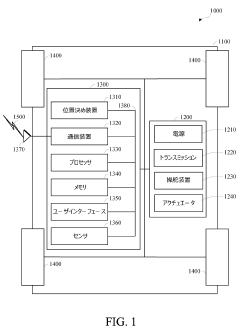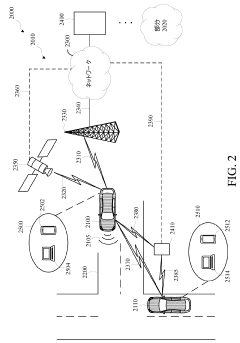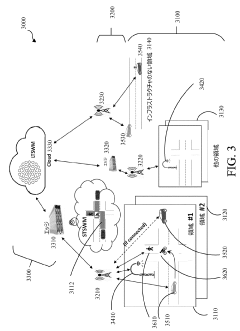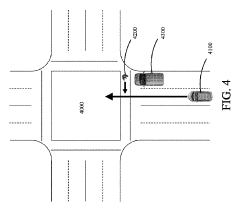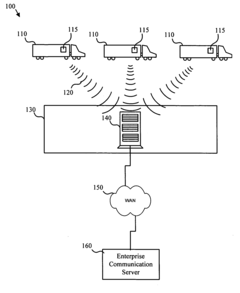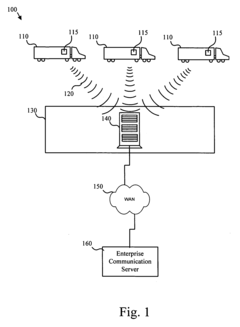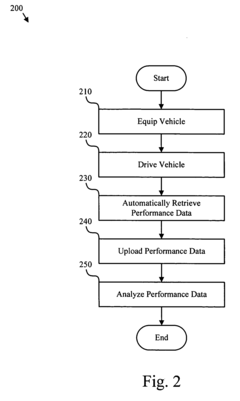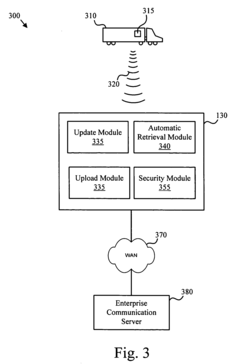K24 Engine Frameworks: Building Tomorrow’s Vehicle Technology
JUL 3, 20259 MIN READ
Generate Your Research Report Instantly with AI Agent
Patsnap Eureka helps you evaluate technical feasibility & market potential.
K24 Engine Framework Evolution and Objectives
The K24 Engine Framework represents a significant evolution in vehicle technology, marking a paradigm shift in how automotive systems are designed and integrated. This framework has its roots in the early 2000s when the automotive industry began to recognize the need for more sophisticated software architectures to manage the increasing complexity of vehicle systems.
The primary objective of the K24 Engine Framework is to create a unified, scalable, and flexible platform that can support the development of next-generation vehicles. It aims to streamline the integration of various vehicle subsystems, including powertrain control, advanced driver assistance systems (ADAS), infotainment, and connectivity features. By providing a standardized architecture, K24 seeks to reduce development time, improve system reliability, and enhance overall vehicle performance.
Over the past two decades, the K24 framework has undergone several iterations, each addressing the evolving needs of the automotive industry. The initial versions focused on basic engine management and vehicle diagnostics. Subsequent updates incorporated support for hybrid and electric powertrains, reflecting the industry's shift towards electrification. Recent iterations have emphasized the integration of artificial intelligence and machine learning capabilities, enabling more advanced autonomous driving features and predictive maintenance systems.
A key objective of the K24 framework is to facilitate the development of software-defined vehicles. This concept envisions cars as platforms that can be continuously updated and improved through over-the-air software updates, similar to smartphones. By adopting this approach, automakers aim to extend the lifespan of vehicles, introduce new features post-purchase, and maintain a competitive edge in a rapidly evolving market.
The framework also aims to address the growing cybersecurity concerns in connected vehicles. As cars become more reliant on software and connectivity, ensuring robust security measures is paramount. The K24 framework incorporates advanced encryption protocols and secure communication channels to protect against potential cyber threats and unauthorized access to vehicle systems.
Looking ahead, the K24 Engine Framework is poised to play a crucial role in shaping the future of automotive technology. Its continued evolution will likely focus on further enhancing interoperability between different vehicle systems, improving energy efficiency in both conventional and electric powertrains, and supporting the development of fully autonomous vehicles. As the automotive industry moves towards more sustainable and intelligent transportation solutions, the K24 framework will undoubtedly remain at the forefront of innovation, driving the next generation of vehicle technology.
The primary objective of the K24 Engine Framework is to create a unified, scalable, and flexible platform that can support the development of next-generation vehicles. It aims to streamline the integration of various vehicle subsystems, including powertrain control, advanced driver assistance systems (ADAS), infotainment, and connectivity features. By providing a standardized architecture, K24 seeks to reduce development time, improve system reliability, and enhance overall vehicle performance.
Over the past two decades, the K24 framework has undergone several iterations, each addressing the evolving needs of the automotive industry. The initial versions focused on basic engine management and vehicle diagnostics. Subsequent updates incorporated support for hybrid and electric powertrains, reflecting the industry's shift towards electrification. Recent iterations have emphasized the integration of artificial intelligence and machine learning capabilities, enabling more advanced autonomous driving features and predictive maintenance systems.
A key objective of the K24 framework is to facilitate the development of software-defined vehicles. This concept envisions cars as platforms that can be continuously updated and improved through over-the-air software updates, similar to smartphones. By adopting this approach, automakers aim to extend the lifespan of vehicles, introduce new features post-purchase, and maintain a competitive edge in a rapidly evolving market.
The framework also aims to address the growing cybersecurity concerns in connected vehicles. As cars become more reliant on software and connectivity, ensuring robust security measures is paramount. The K24 framework incorporates advanced encryption protocols and secure communication channels to protect against potential cyber threats and unauthorized access to vehicle systems.
Looking ahead, the K24 Engine Framework is poised to play a crucial role in shaping the future of automotive technology. Its continued evolution will likely focus on further enhancing interoperability between different vehicle systems, improving energy efficiency in both conventional and electric powertrains, and supporting the development of fully autonomous vehicles. As the automotive industry moves towards more sustainable and intelligent transportation solutions, the K24 framework will undoubtedly remain at the forefront of innovation, driving the next generation of vehicle technology.
Market Demand for Advanced Vehicle Technologies
The automotive industry is witnessing a significant shift towards advanced vehicle technologies, driven by increasing consumer demand for safer, more efficient, and environmentally friendly transportation solutions. The K24 Engine Framework represents a cutting-edge approach to developing next-generation vehicle technologies, and its market potential is substantial.
Consumer preferences are evolving rapidly, with a growing emphasis on connected, autonomous, shared, and electric (CASE) vehicles. This trend is reflected in the rising demand for advanced driver assistance systems (ADAS), infotainment systems, and electrification technologies. Market research indicates that the global connected car market is expected to grow at a compound annual growth rate (CAGR) of over 17% from 2021 to 2026, highlighting the increasing consumer appetite for advanced vehicle technologies.
The push for autonomous vehicles is another key driver of market demand. While fully autonomous vehicles are still in development, there is a strong market for vehicles with varying levels of autonomy. The global autonomous vehicle market is projected to expand significantly in the coming years, with some estimates suggesting it could reach a value of several hundred billion dollars by 2030.
Electrification is perhaps the most transformative trend in the automotive industry. The global electric vehicle (EV) market has been growing exponentially, with sales doubling in 2021 compared to the previous year. This growth is expected to continue as governments worldwide implement stricter emissions regulations and offer incentives for EV adoption.
The K24 Engine Framework's potential to integrate these advanced technologies seamlessly makes it particularly attractive to automakers and consumers alike. Its modular and scalable nature allows for the incorporation of various advanced features, from enhanced connectivity to improved powertrain efficiency, aligning well with current market demands.
Moreover, there is a growing market demand for vehicles that offer improved fuel efficiency and reduced emissions, even in traditional internal combustion engine (ICE) vehicles. The K24 Engine Framework's potential to optimize engine performance and reduce fuel consumption addresses this market need directly.
In the commercial vehicle sector, there is increasing demand for advanced fleet management systems and telematics solutions. The K24 Engine Framework's capabilities in data collection and analysis could provide significant value in this market segment, offering improved vehicle diagnostics, predictive maintenance, and operational efficiency.
The aftermarket and retrofit market also present significant opportunities for the K24 Engine Framework. As consumers seek to upgrade their existing vehicles with advanced technologies, solutions that can be easily integrated into older vehicle models become increasingly valuable.
In conclusion, the market demand for advanced vehicle technologies that the K24 Engine Framework aims to support is robust and growing. From electrification and autonomy to connectivity and improved efficiency, the framework addresses key trends shaping the automotive industry's future. As such, it is well-positioned to capitalize on the evolving needs of both consumers and automakers in the rapidly changing automotive landscape.
Consumer preferences are evolving rapidly, with a growing emphasis on connected, autonomous, shared, and electric (CASE) vehicles. This trend is reflected in the rising demand for advanced driver assistance systems (ADAS), infotainment systems, and electrification technologies. Market research indicates that the global connected car market is expected to grow at a compound annual growth rate (CAGR) of over 17% from 2021 to 2026, highlighting the increasing consumer appetite for advanced vehicle technologies.
The push for autonomous vehicles is another key driver of market demand. While fully autonomous vehicles are still in development, there is a strong market for vehicles with varying levels of autonomy. The global autonomous vehicle market is projected to expand significantly in the coming years, with some estimates suggesting it could reach a value of several hundred billion dollars by 2030.
Electrification is perhaps the most transformative trend in the automotive industry. The global electric vehicle (EV) market has been growing exponentially, with sales doubling in 2021 compared to the previous year. This growth is expected to continue as governments worldwide implement stricter emissions regulations and offer incentives for EV adoption.
The K24 Engine Framework's potential to integrate these advanced technologies seamlessly makes it particularly attractive to automakers and consumers alike. Its modular and scalable nature allows for the incorporation of various advanced features, from enhanced connectivity to improved powertrain efficiency, aligning well with current market demands.
Moreover, there is a growing market demand for vehicles that offer improved fuel efficiency and reduced emissions, even in traditional internal combustion engine (ICE) vehicles. The K24 Engine Framework's potential to optimize engine performance and reduce fuel consumption addresses this market need directly.
In the commercial vehicle sector, there is increasing demand for advanced fleet management systems and telematics solutions. The K24 Engine Framework's capabilities in data collection and analysis could provide significant value in this market segment, offering improved vehicle diagnostics, predictive maintenance, and operational efficiency.
The aftermarket and retrofit market also present significant opportunities for the K24 Engine Framework. As consumers seek to upgrade their existing vehicles with advanced technologies, solutions that can be easily integrated into older vehicle models become increasingly valuable.
In conclusion, the market demand for advanced vehicle technologies that the K24 Engine Framework aims to support is robust and growing. From electrification and autonomy to connectivity and improved efficiency, the framework addresses key trends shaping the automotive industry's future. As such, it is well-positioned to capitalize on the evolving needs of both consumers and automakers in the rapidly changing automotive landscape.
Current K24 Engine Framework Challenges
The K24 Engine Framework, while revolutionary in its approach to vehicle technology, faces several significant challenges in its current state. One of the primary issues is the complexity of integrating diverse systems within a unified framework. As vehicles become increasingly sophisticated, incorporating advanced driver assistance systems (ADAS), infotainment, and powertrain management, the K24 framework struggles to seamlessly connect these disparate components.
Another challenge lies in the real-time performance requirements of modern vehicles. The K24 framework must process vast amounts of data from multiple sensors and systems simultaneously, making low-latency response critical. However, achieving this level of performance while maintaining system stability and reliability has proven difficult, particularly in edge cases and unexpected scenarios.
Scalability is also a major concern for the K24 Engine Framework. As automotive technology rapidly evolves, the framework needs to accommodate new features and functionalities without requiring a complete overhaul. This adaptability is crucial for future-proofing vehicle systems but presents significant engineering challenges in terms of architecture design and resource allocation.
Security and safety considerations pose another set of hurdles for the K24 framework. With the increasing connectivity of vehicles, protecting against cyber threats and ensuring the integrity of critical systems is paramount. The framework must implement robust security measures without compromising performance or user experience, a balance that is often difficult to achieve.
Furthermore, the K24 Engine Framework faces challenges in standardization and interoperability. As different manufacturers and suppliers develop their own implementations, ensuring compatibility across various platforms and components becomes increasingly complex. This fragmentation can lead to increased development costs and longer time-to-market for new vehicle technologies.
Energy efficiency is another area where the K24 framework encounters difficulties. As the automotive industry shifts towards electrification, optimizing power consumption within the framework becomes crucial. Balancing performance requirements with energy conservation presents a significant engineering challenge, particularly in the context of electric and hybrid vehicles.
Lastly, the K24 Engine Framework must address the growing demand for over-the-air (OTA) updates and continuous improvement capabilities. Implementing a robust and secure OTA system within the framework, while ensuring minimal disruption to vehicle operation, remains a complex task that requires careful consideration of both technical and user experience factors.
Another challenge lies in the real-time performance requirements of modern vehicles. The K24 framework must process vast amounts of data from multiple sensors and systems simultaneously, making low-latency response critical. However, achieving this level of performance while maintaining system stability and reliability has proven difficult, particularly in edge cases and unexpected scenarios.
Scalability is also a major concern for the K24 Engine Framework. As automotive technology rapidly evolves, the framework needs to accommodate new features and functionalities without requiring a complete overhaul. This adaptability is crucial for future-proofing vehicle systems but presents significant engineering challenges in terms of architecture design and resource allocation.
Security and safety considerations pose another set of hurdles for the K24 framework. With the increasing connectivity of vehicles, protecting against cyber threats and ensuring the integrity of critical systems is paramount. The framework must implement robust security measures without compromising performance or user experience, a balance that is often difficult to achieve.
Furthermore, the K24 Engine Framework faces challenges in standardization and interoperability. As different manufacturers and suppliers develop their own implementations, ensuring compatibility across various platforms and components becomes increasingly complex. This fragmentation can lead to increased development costs and longer time-to-market for new vehicle technologies.
Energy efficiency is another area where the K24 framework encounters difficulties. As the automotive industry shifts towards electrification, optimizing power consumption within the framework becomes crucial. Balancing performance requirements with energy conservation presents a significant engineering challenge, particularly in the context of electric and hybrid vehicles.
Lastly, the K24 Engine Framework must address the growing demand for over-the-air (OTA) updates and continuous improvement capabilities. Implementing a robust and secure OTA system within the framework, while ensuring minimal disruption to vehicle operation, remains a complex task that requires careful consideration of both technical and user experience factors.
Existing K24 Engine Framework Solutions
01 Software development frameworks for K24 engines
Specialized software frameworks designed for K24 engine development, focusing on optimizing performance, fuel efficiency, and emissions control. These frameworks provide tools for engine modeling, simulation, and calibration, enabling engineers to streamline the development process and improve overall engine performance.- Software development frameworks for K24 engines: Various software development frameworks are utilized for K24 engine systems. These frameworks provide tools and libraries for efficient development of engine control software, including real-time processing, data management, and system integration capabilities. They enable developers to create robust and optimized software solutions for K24 engine applications.
- Engine control unit (ECU) frameworks for K24 engines: Specialized ECU frameworks are designed for K24 engine management. These frameworks incorporate advanced algorithms for fuel injection, ignition timing, and emissions control. They often include modular architectures that allow for customization and easy updates to meet evolving performance and regulatory requirements.
- Data analysis and diagnostic frameworks for K24 engines: Frameworks for data analysis and diagnostics are crucial for K24 engine performance optimization and maintenance. These systems collect and process engine data in real-time, providing insights into engine health, performance metrics, and potential issues. They often incorporate machine learning algorithms for predictive maintenance and fault detection.
- Communication and networking frameworks for K24 engine systems: Advanced communication and networking frameworks are implemented in K24 engine systems to facilitate data exchange between various components and external systems. These frameworks enable seamless integration with vehicle networks, diagnostic tools, and cloud-based services, supporting features such as remote diagnostics and over-the-air updates.
- Simulation and testing frameworks for K24 engine development: Simulation and testing frameworks play a crucial role in K24 engine development and optimization. These frameworks provide virtual environments for engine modeling, performance analysis, and validation of control strategies. They enable engineers to conduct extensive testing and refinement before physical prototyping, reducing development time and costs.
02 Engine control unit (ECU) frameworks for K24 engines
Advanced ECU frameworks tailored for K24 engines, incorporating real-time data processing, adaptive control algorithms, and diagnostic capabilities. These frameworks enable precise engine management, improved fuel economy, and enhanced emissions control, while also supporting over-the-air updates and integration with vehicle networks.Expand Specific Solutions03 Testing and validation frameworks for K24 engines
Comprehensive testing and validation frameworks specifically designed for K24 engines, including hardware-in-the-loop simulations, automated test procedures, and data analysis tools. These frameworks help ensure reliability, durability, and compliance with emissions regulations throughout the engine development lifecycle.Expand Specific Solutions04 Integration frameworks for K24 engines in vehicle systems
Frameworks facilitating the integration of K24 engines with various vehicle systems, such as transmission control, hybrid powertrains, and advanced driver assistance systems. These frameworks enable seamless communication and coordination between the engine and other vehicle components, optimizing overall performance and efficiency.Expand Specific Solutions05 Data analytics and machine learning frameworks for K24 engines
Advanced data analytics and machine learning frameworks applied to K24 engine development and optimization. These frameworks leverage big data techniques, predictive modeling, and artificial intelligence to enhance engine performance, predict maintenance needs, and support continuous improvement in engine design and calibration.Expand Specific Solutions
Key Players in K24 Engine Development
The K24 Engine Framework research for future vehicle technology is in an early development stage, with significant potential for market growth as the automotive industry shifts towards more advanced and sustainable solutions. The market size is expected to expand rapidly as major automakers invest in next-generation powertrain technologies. Companies like Honda, GM, Toyota, and Ford are at the forefront, leveraging their extensive R&D capabilities to develop innovative K24 Engine Frameworks. While the technology is not yet fully mature, these industry leaders are making substantial progress, with varying degrees of advancement in their respective approaches. Emerging players and research institutions are also contributing to the competitive landscape, fostering a dynamic environment for technological breakthroughs in this crucial area of automotive engineering.
Toyota Motor Corp.
Technical Solution: Toyota's K24 engine framework research focuses on developing a highly efficient and versatile platform for next-generation vehicles. The company is exploring advanced combustion technologies, including lean-burn strategies and variable valve timing, to optimize fuel efficiency and reduce emissions[1]. Toyota is also integrating hybrid and electric powertrain components into the K24 framework, allowing for flexible powertrain configurations that can adapt to various market demands and regulatory requirements[3]. Additionally, the company is investigating the use of lightweight materials and modular design principles to enhance the engine's power-to-weight ratio and simplify manufacturing processes[5].
Strengths: Toyota's extensive experience in hybrid technology and lean manufacturing gives them an edge in developing efficient and cost-effective K24 frameworks. Weaknesses: The company may face challenges in rapidly adapting to fully electric powertrains, which could limit the long-term viability of their K24 engine research.
Ford Global Technologies LLC
Technical Solution: Ford's approach to K24 engine frameworks involves a comprehensive strategy aimed at future-proofing their vehicle technology. The company is developing a modular architecture that can accommodate various propulsion systems, from traditional internal combustion engines to hybrid and full electric powertrains[2]. Ford is incorporating advanced materials science, utilizing high-strength alloys and composite materials to reduce weight while maintaining structural integrity[4]. The K24 framework also integrates smart sensors and AI-driven control systems to optimize performance and efficiency in real-time, adapting to driving conditions and user preferences[6]. Furthermore, Ford is exploring the integration of sustainable biofuels and synthetic fuels compatibility into the K24 platform, ensuring versatility in markets with diverse energy landscapes[8].
Strengths: Ford's modular approach allows for rapid adaptation to market trends and regulatory changes. Their focus on AI and smart systems positions them well for the connected car future. Weaknesses: The broad scope of their research may lead to longer development cycles and higher costs compared to more focused competitors.
Core Innovations in K24 Engine Design
A Computing Framework for Vehicle Decision-Making and Traffic Management
PatentPendingJP2024526845A
Innovation
- A computing framework utilizing edge and cloud computing nodes to process and distribute real-time and non-real-time transportation network data, employing a two-layer shared world model (STSWM and LTSWM) to facilitate immediate and long-term vehicle decision-making and coordination.
Apparatus, system, and method for improving engine development
PatentActiveUS20070038342A1
Innovation
- A system comprising a data logger equipped with sensors, a secure local wireless network, and an enterprise communication server for automatic and secure data collection, retrieval, and analysis via a VPN over the internet, enabling long-distance, automated, and secure engine development, with features like encryption and MAC address authentication.
Environmental Impact of K24 Engines
The environmental impact of K24 engines is a critical consideration in the development of tomorrow's vehicle technology. These engines, known for their efficiency and performance, have both positive and negative effects on the environment.
K24 engines have demonstrated improved fuel efficiency compared to their predecessors, resulting in reduced carbon dioxide emissions per mile driven. This efficiency gain contributes to lower greenhouse gas emissions and helps mitigate climate change impacts. Additionally, the advanced combustion technology in K24 engines leads to more complete fuel burning, reducing the release of harmful pollutants such as carbon monoxide and unburned hydrocarbons.
However, the production of K24 engines still involves resource-intensive processes and materials. The manufacturing of lightweight components, while beneficial for fuel efficiency, often requires energy-intensive processes and rare earth elements. This raises concerns about resource depletion and the environmental impact of mining and refining these materials.
The longevity and durability of K24 engines contribute to their environmental profile. With proper maintenance, these engines can last for many years, reducing the need for frequent replacements and the associated environmental costs of manufacturing new engines. This durability also supports the circular economy concept, as many components can be refurbished or recycled at the end of the engine's life cycle.
Noise pollution is another environmental aspect to consider. K24 engines generally produce less noise than older engine designs, particularly at idle and low speeds. This reduction in noise pollution can have positive effects on urban environments and wildlife habitats near roadways.
The adaptability of K24 engines to alternative fuels is a significant environmental advantage. Many K24 variants can be modified to run on biofuels or synthetic fuels, potentially reducing dependence on fossil fuels and lowering overall carbon footprints. This flexibility aligns with the global push towards renewable energy sources in the transportation sector.
As vehicle electrification gains momentum, the role of K24 engines in hybrid powertrains becomes increasingly relevant. In hybrid configurations, these engines can operate at their most efficient points, further reducing emissions and fuel consumption. This hybrid application serves as a bridge technology, supporting the gradual transition to fully electric vehicles while still offering immediate environmental benefits.
K24 engines have demonstrated improved fuel efficiency compared to their predecessors, resulting in reduced carbon dioxide emissions per mile driven. This efficiency gain contributes to lower greenhouse gas emissions and helps mitigate climate change impacts. Additionally, the advanced combustion technology in K24 engines leads to more complete fuel burning, reducing the release of harmful pollutants such as carbon monoxide and unburned hydrocarbons.
However, the production of K24 engines still involves resource-intensive processes and materials. The manufacturing of lightweight components, while beneficial for fuel efficiency, often requires energy-intensive processes and rare earth elements. This raises concerns about resource depletion and the environmental impact of mining and refining these materials.
The longevity and durability of K24 engines contribute to their environmental profile. With proper maintenance, these engines can last for many years, reducing the need for frequent replacements and the associated environmental costs of manufacturing new engines. This durability also supports the circular economy concept, as many components can be refurbished or recycled at the end of the engine's life cycle.
Noise pollution is another environmental aspect to consider. K24 engines generally produce less noise than older engine designs, particularly at idle and low speeds. This reduction in noise pollution can have positive effects on urban environments and wildlife habitats near roadways.
The adaptability of K24 engines to alternative fuels is a significant environmental advantage. Many K24 variants can be modified to run on biofuels or synthetic fuels, potentially reducing dependence on fossil fuels and lowering overall carbon footprints. This flexibility aligns with the global push towards renewable energy sources in the transportation sector.
As vehicle electrification gains momentum, the role of K24 engines in hybrid powertrains becomes increasingly relevant. In hybrid configurations, these engines can operate at their most efficient points, further reducing emissions and fuel consumption. This hybrid application serves as a bridge technology, supporting the gradual transition to fully electric vehicles while still offering immediate environmental benefits.
K24 Engine Safety and Regulations
The K24 Engine Framework represents a significant leap forward in vehicle technology, necessitating a comprehensive approach to safety and regulatory compliance. As automotive systems become increasingly complex and interconnected, ensuring the safety and reliability of K24-powered vehicles is paramount.
Safety considerations for K24 engines encompass both hardware and software components. On the hardware side, robust fail-safe mechanisms must be implemented to prevent catastrophic failures. This includes redundant systems for critical functions, advanced sensor networks for real-time monitoring, and intelligent thermal management to maintain optimal operating conditions. Software safety measures are equally crucial, with emphasis on secure communication protocols, tamper-resistant firmware, and rigorous testing methodologies to identify and mitigate potential vulnerabilities.
Regulatory compliance for K24 engines spans multiple jurisdictions and covers various aspects of vehicle operation. Emissions standards are a primary concern, with stringent requirements set by agencies such as the Environmental Protection Agency (EPA) in the United States and the European Union's Euro emissions standards. K24 engines must demonstrate compliance with these regulations through advanced combustion control, exhaust after-treatment systems, and sophisticated engine management software.
Safety regulations also play a significant role in K24 engine development. Standards set by organizations like the National Highway Traffic Safety Administration (NHTSA) in the US and the European New Car Assessment Programme (Euro NCAP) dictate requirements for crash safety, pedestrian protection, and advanced driver assistance systems (ADAS). K24 engines must be designed to integrate seamlessly with these safety features, providing the necessary power and control while maintaining structural integrity in collision scenarios.
Cybersecurity regulations are becoming increasingly important as vehicles become more connected. Standards such as the UN Regulation No. 155 on Cyber Security and Cyber Security Management System (CSMS) require manufacturers to implement robust security measures to protect K24-powered vehicles from cyber threats. This includes secure over-the-air (OTA) update capabilities, intrusion detection systems, and secure data storage and transmission protocols.
As autonomous driving technologies advance, K24 engines must also comply with emerging regulations governing self-driving vehicles. These regulations, which are still evolving in many jurisdictions, focus on ensuring the safety and reliability of autonomous systems, including the engine's role in providing consistent power and responsiveness to support autonomous decision-making and control.
Manufacturers developing K24 engine frameworks must navigate this complex regulatory landscape while pushing the boundaries of innovation. Collaboration with regulatory bodies, participation in industry standards development, and proactive engagement in policy discussions are essential strategies for ensuring compliance and shaping future regulations that support technological advancement while prioritizing safety and environmental protection.
Safety considerations for K24 engines encompass both hardware and software components. On the hardware side, robust fail-safe mechanisms must be implemented to prevent catastrophic failures. This includes redundant systems for critical functions, advanced sensor networks for real-time monitoring, and intelligent thermal management to maintain optimal operating conditions. Software safety measures are equally crucial, with emphasis on secure communication protocols, tamper-resistant firmware, and rigorous testing methodologies to identify and mitigate potential vulnerabilities.
Regulatory compliance for K24 engines spans multiple jurisdictions and covers various aspects of vehicle operation. Emissions standards are a primary concern, with stringent requirements set by agencies such as the Environmental Protection Agency (EPA) in the United States and the European Union's Euro emissions standards. K24 engines must demonstrate compliance with these regulations through advanced combustion control, exhaust after-treatment systems, and sophisticated engine management software.
Safety regulations also play a significant role in K24 engine development. Standards set by organizations like the National Highway Traffic Safety Administration (NHTSA) in the US and the European New Car Assessment Programme (Euro NCAP) dictate requirements for crash safety, pedestrian protection, and advanced driver assistance systems (ADAS). K24 engines must be designed to integrate seamlessly with these safety features, providing the necessary power and control while maintaining structural integrity in collision scenarios.
Cybersecurity regulations are becoming increasingly important as vehicles become more connected. Standards such as the UN Regulation No. 155 on Cyber Security and Cyber Security Management System (CSMS) require manufacturers to implement robust security measures to protect K24-powered vehicles from cyber threats. This includes secure over-the-air (OTA) update capabilities, intrusion detection systems, and secure data storage and transmission protocols.
As autonomous driving technologies advance, K24 engines must also comply with emerging regulations governing self-driving vehicles. These regulations, which are still evolving in many jurisdictions, focus on ensuring the safety and reliability of autonomous systems, including the engine's role in providing consistent power and responsiveness to support autonomous decision-making and control.
Manufacturers developing K24 engine frameworks must navigate this complex regulatory landscape while pushing the boundaries of innovation. Collaboration with regulatory bodies, participation in industry standards development, and proactive engagement in policy discussions are essential strategies for ensuring compliance and shaping future regulations that support technological advancement while prioritizing safety and environmental protection.
Unlock deeper insights with Patsnap Eureka Quick Research — get a full tech report to explore trends and direct your research. Try now!
Generate Your Research Report Instantly with AI Agent
Supercharge your innovation with Patsnap Eureka AI Agent Platform!
